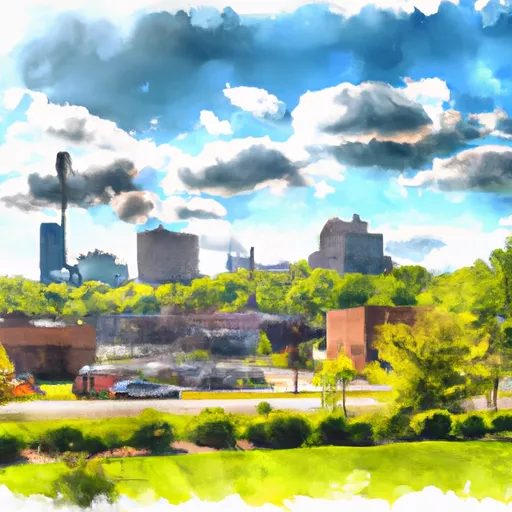-
 Snoflo Premium
Snoflo Premium
Get unlimited access to all our content
With no Ad interruptions! - Start Your Free Trial Login with existing account
Riverdale
Eden Index
Climate
8.4
•
Recreation
3.5
•
Community
•
Safeguard
4.6/10

Located in Montcalm County, Michigan, Riverdale is a small village with a population of approximately 1,000 residents. The climate in Riverdale is characterized by cold winters and warm summers. With an average annual temperature of 48°F, residents and visitors experience mild variations in temperature throughout the year.
The hydrology constituents of Riverdale are primarily influenced by the presence of the Maple River, which flows through the village. The river provides a picturesque setting for recreational activities such as fishing, canoeing, and kayaking. Anglers can enjoy catching a variety of fish species, including trout, bass, and panfish.
In addition to the Maple River, Riverdale is surrounded by lush forests and natural landscapes, offering outdoor enthusiasts various opportunities for exploration and recreation. The village is close to several state parks, including the Fred Meijer Heartland Trail, a 41-mile paved trail ideal for biking, jogging, or walking. The nearby state forests provide ample opportunities for hiking, camping, and wildlife viewing.
Overall, Riverdale, Michigan, offers a pleasant climate, a scenic river, and abundant outdoor recreational activities, making it an attractive destination for nature lovers and outdoor enthusiasts.
What is the Eden Index?
The Snoflo Eden Index serves as a comprehensive rating system for regions, evaluating their desirability through a holistic assessment of climate health, outdoor recreation opportunities, and natural disaster risk, acknowledging the profound impact of these factors on livability and well-being.
Climate Health Indicator (CHI): 8.4
Riverdale receives approximately
822mm of rain per year,
with humidity levels near 79%
and air temperatures averaging around
8°C.
Riverdale has a plant hardyness factor of
5, meaning
plants and agriculture in this region thrive during a short period during spring and early summer. Most
plants will die off during the colder winter months.
By considering the ideal temperature range, reliable water supplies, clean air, and stable seasonal rain or snowpacks, the Climate Health Indicator (CHI) underscores the significance of a healthy climate as the foundation for quality living.
A healthy climate is paramount for ensuring a high quality of life and livability in a region, fostering both physical well-being and environmental harmony. This can be characterized by ideal temperatures, reliable access to water supplies, clean air, and consistent seasonal rain or snowpacks.
Weather Forecast
Streamflow Conditions
Saginaw
Area Rivers
Saginaw
Snowpack Depths
Saginaw
Reservoir Storage Capacity
Saginaw
Groundwater Levels
Recreational Opportunity Index (ROI): 3.5
The Recreational Opportunity Index (ROI) recognizes the value of outdoor recreational options, such as parks, hiking trails, camping sites, and fishing spots, while acknowledging that climate plays a pivotal role in ensuring the comfort and consistency of these experiences.
Access to outdoor recreational opportunities, encompassing activities such as parks, hiking, camping, and fishing, is crucial for overall well-being, and the climate plays a pivotal role in enabling and enhancing these experiences, ensuring that individuals can engage in nature-based activities comfortably and consistently.
Camping Areas
| Campground | Campsites | Reservations | Toilets | Showers | Elevation |
|---|---|---|---|---|---|
| Cecil Lakeview City Park | None | 579 ft | |||
| Wilderness State Park | 250 | 594 ft | |||
| Camp Petosega | None | 673 ft | |||
| Maple Bay - State Forest | 38 | 600 ft | |||
| Marble Lake County Park | None | 995 ft | |||
| Steuben County Park | None | 1,019 ft | |||
| Memorial Park Campground - Coldwater | None | 927 ft | |||
| Petoskey State Park | 165 | 600 ft | |||
| Branch County Fairgrounds RV | None | 961 ft | |||
| Pokagon State Park | 275 | 1,026 ft |
Nearby Ski Areas
Catastrophe Safeguard Index (CSI):
The Catastrophe Safeguard Index (CSI) recognizes that natural disaster risk, encompassing floods, fires, hurricanes, and tornadoes, can drastically affect safety and the overall appeal of an area.
The level of natural disaster risk in a region significantly affects safety and the overall livability, with climate change amplifying these risks by potentially increasing the frequency and intensity of events like floods, fires, hurricanes, and tornadoes, thereby posing substantial challenges to community resilience and well-being.
Community Resilience Indicator (CRI):
The Community Resilience Indicator (CRI) recognizes that education, healthcare, and socioeconomics are crucial to the well-being of a region. The CRI acknowledges the profound impact of these elements on residents' overall quality of life. By evaluating educational resources, healthcare accessibility, and economic inclusivity, the index captures the essential aspects that contribute to a thriving community, fostering resident satisfaction, equity, and social cohesion.

